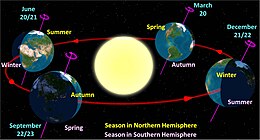| Winter Solstice | |
|---|---|
 Sunset at Stonehenge in England during the winter solstice in the Northern Hemisphere | |
| Also called | Midwinter; the Shortest Day; the Longest Night |
| Observed by | Various cultures |
| Type | Cultural, astronomical |
| Significance | Beginning of lengthening days and shortening nights |
| Celebrations | Feasting |
| Date | December 21, December 22, or December 23 (Northern Hemisphere) and June 20, June 21, or June 22 (Southern Hemisphere) |
| Related to | Winter festivals |

The winter solstice, also called the hibernal solstice, occurs when either of Earth's poles reaches its maximum tilt away from the Sun. This happens twice yearly, once in each hemisphere (Northern and Southern). For that hemisphere, the winter solstice is the day with the shortest period of daylight and longest night of the year, and when the Sun is at its lowest daily maximum elevation in the sky.[1] Each polar region experiences continuous darkness or twilight around its winter solstice. The opposite event is the summer solstice.
The winter solstice occurs during the hemisphere's winter. In the Northern Hemisphere, this is the December solstice (December 21, December 22, or December 23) and in the Southern Hemisphere, this is the June solstice (June 20, June 21, or June 22). Although the winter solstice itself lasts only a moment, the term also refers to the day on which it occurs. The term midwinter is also used synonymously with the winter solstice, although it carries other meanings as well. Traditionally, in many temperate regions, the winter solstice is seen as the middle of winter; although today in some countries and calendars it is seen as the beginning of winter. Other names are the "extreme of winter" (Dongzhi), or the "shortest day".
Since prehistory, the winter solstice has been a significant time of year in many cultures and has been marked by festivals and rites.[2] It marked the symbolic death and rebirth of the Sun; the gradual waning of daylight hours is reversed and begins to grow again. Some ancient monuments such as Newgrange, Stonehenge, Cahokia Woodhenge, and Ahu Tongariki are aligned with the sunrise or sunset on the winter solstice.
- ^ Shipman, James; Wilson, Jerry D.; Todd, Aaron (2007). "Section 15.5". An Introduction to Physical Science (12th ed.). Boston: Houghton Mifflin. p. 423. ISBN 978-0-618-92696-1.
- ^ "Winter Solstice celebrations: a.k.a. Christmas, Saturnalia, Yule, the Long Night, the start of Winter, etc". Religious Tolerance.org. August 5, 2015 [December 3, 1999].